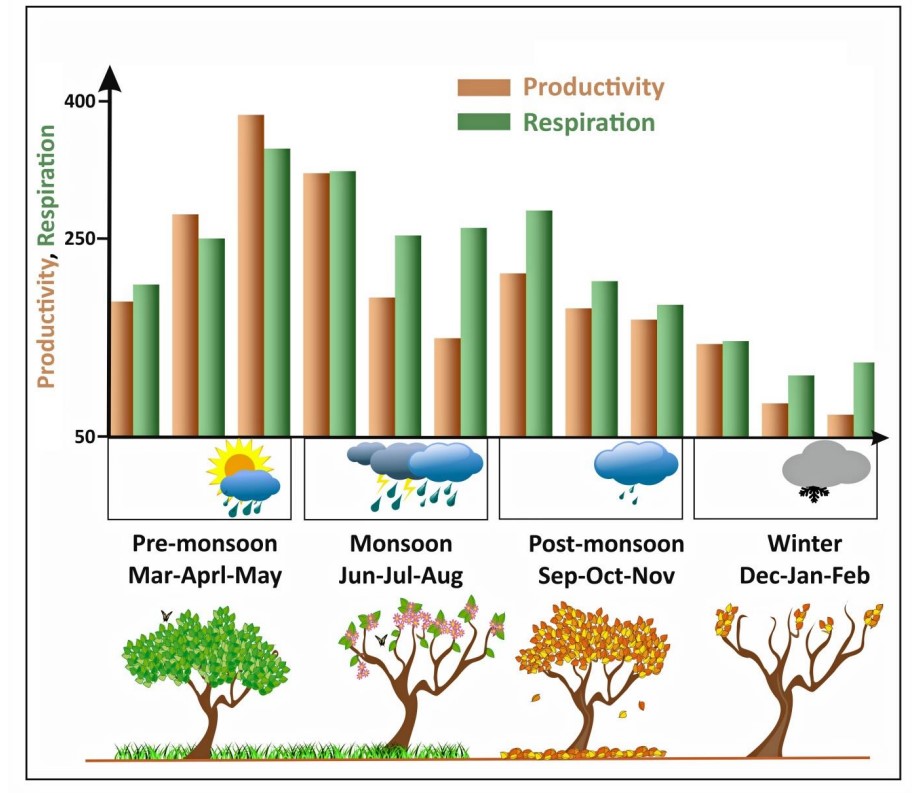Ministry of Earth Sciences
Carbon removal capacity of the forest in northeast India may reduce over time: IITM Study
Posted On:
11 FEB 2022 2:50PM by PIB Mumbai
: Mumbai, February 11, 2022
According to a study by the scientists from Indian Institute of Tropical Meteorology, Pune, and Tezpur University at Tezpur ‘Carbon removal capacity of the forest in northeast India may reduce over time’. The scientists from IITM, Pune, and Tezpur University at Tezpur are investigating carbon movement processes at a deciduous forest in northeast India, known as the Kaziranga National Park.
The scientists observed that the Kaziranga forest removes maximum carbon from the atmosphere before the monsoon season, typically during March-April-May.

During the monsoon season, increased cloud cover limits the photosynthetic activity, hence the plants’ carbon absorption capacity weakens. And in the post-monsoon and winter season, this forest emits a significant amount of carbon. Respiration remains higher than productivity from July to the rest of the year.
According to the scientists, multi-year data analysis shows that the Kaziranga forest may not be a carbon sink. That means annually, it releases more amount of CO2 than it absorbs. The reason for this unusual behaviour lies in the soil. Due to the high bacterial population, the Kaziranga soil emits significant CO2, known as heterotrophic respiration. Eddy-covariance measurements carried out by the National Remote Sensing Center, Hyderabad, in other Indian forests, such as a teak forest in Madhya Pradesh, show that they act mainly as a carbon sink. In that sense, the Kaziranga forest is behaving differently. The study is recently published in an Elsevier journal, Agricultural and Forest Meteorology.
The IITM scientists further analysed the isotopic composition of rainwater collected in a few places in northeast India. A water molecule contains two hydrogen atoms and one oxygen atom. The isotopes, which are the atoms of the same element but of different masses, behave slightly differently during certain physical processes. At Kaziranga, during the pre-monsoon season, when plant productivity is high, they also release a high amount of water, known as transpiration. The transpired water vapor also contributes to rainfall; this is maximum during the pre-monsoon season in Kaziranga forest. Scientists have noted that during this time, the plant transpired water vapor contains a relatively more number of heavier isotopes than any other season in the year. Through the isotopic and other means of investigation, the IITM scientists observed a strong link between the hydrological and carbon cycles, which may be unique to the Kaziranga ecosystem.
Under the MetFlux India project, sponsored by the Ministry of Earth Sciences, Govt. of India, in 2015 the scientists installed a meteorological tower containing a variety of sensors and equipment. One of these sensors placed above the forest canopy measures CO2 and water vapor concentrations; another sensor measures the wind speed and direction. The concentration and wind speed analysis tells how much carbon is absorbed or released by the forest ecosystem. When one year of measurement is completed, the carbon sequestration capacity of the forest can be assessed.

Under the global warming scenario, the study may have concerning implications. Analysis of the rainfall data shows that rainfall in this region has decreased for several decades, especially during the pre-monsoon season. The amount of rainfall derived from the locally generated moisture, through transpiration, is also experiencing a reducing trend this season. This is especially significant for March-April because this is the time an enhanced hydrological cycle triggers the primary productivity. A reducing trend in rainfall may affect both the ecosystem productivity and the transpiration process. If the plant productivity weakens, it may further affect the carbon sequestration capacity of this fragile ecosystem of northeast India. So, over a long-term period, the forest may emit more CO2 into the atmosphere. The study is recently published in a Nature Group Journal, Climate and Atmospheric Science.
Trees and plants play a critical role in controlling atmospheric carbon dioxide variations through complex biogeochemical processes. The plants absorb atmospheric carbon dioxide (CO2) through photosynthesis and release CO2 through respiration. When photosynthetic carbon uptake by a forest ecosystem exceeds the amount of carbon emitted by respiration, a net amount of carbon is removed from the atmosphere. The process is known as a carbon sink. It is believed that the forests, in general, act as a carbon sink. However, the carbon sink characteristics depend on various environmental conditions, which need to be monitored to assess the carbon sequestration potential of a given forest. Meteorologists use a sophisticated technique known as Eddy Covariance measurement, which estimates how much carbon is absorbed and released by a forest.
For further information, please contact: Dr. Supriyo Chakraborty, Lead author of Study and Deputy Project Director, Centre for Climate Change Research (CCCR), IITM at supriyo@tropmet.res.in / 020-25904427
IITM PRO/CP/PM
Follow us on social media:  @PIBMumbai
@PIBMumbai  /PIBMumbai
/PIBMumbai  /pibmumbai
/pibmumbai  pibmumbai[at]gmail[dot]com
pibmumbai[at]gmail[dot]com
(Release ID: 1797579)
Visitor Counter : 809